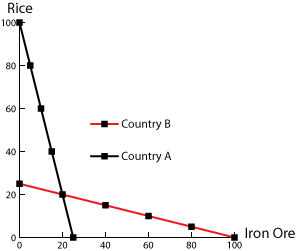|
|
|
|
Absolute Advantage Absolute Advantage exists when a country can produce a good at a lower expense than another country. Say there is Country A whose climate and amount of arable land makes for the profitable cultivation of rice, while Country B's mineral resources make it well suited for production of iron ore. So Country A has an absolute advantage in the production of rice and Country B has an similar advantage in the extracting and refinement of iron ore. As long as there is sufficient demand for both goods in each country (a reasonable assumption considering both are staples in today's era), then there is an opportunity for mutually beneficial trade between the two. Country A and B will only hamstring their commercial power if they try to satisfy their native demand for both goods with domestic production. By not trading- being in a state of autarky- then the individual countries run the risk of thin profit margins and possibly having demand outstrip supply for both goods. These potential problems and the potential for beneficial trade are illustrated in the below tables, with both goods being represented in tons.
Country A | % of Resources Devoted to Rice | Rice | Iron Ore
| | 100% | 100 | 0
| | 80% | 80
| 5
| | 60% | 60
| 10
| | 40% | 40
| 15
| | 20% | 20
| 20
| | 0% | 0 | 25 | | Country B | % of Resources Devoted to Rice | Rice | Iron Ore | | 100% | 25 | 0 | | 80% | 20 | 20 | | 60% | 15 | 40 | | 40% | 10 | 60 | | 20% | 5 | 80 | | 0% | 0 | 100 | | 
As Country A has the means to produce rice more cheaply than Country B, it should focus all or almost all of its production capabilities to the cultivation of rice paddies. Country B clearly has the ability to extract iron ore at a lower cost than Country A, so it would be to its benefit to focus its attention on the mining of iron. Then they could negotiate and come to some trading agreement at what levels of production and trade each will adhere to. If they don't accomplish this, there is the potential for their industries to have a very slim profit margin. They also run the risk of not supplying enough of both goods according to consumer demand, leading to product oversupply and/or undersupply. For instance, consider if Country B decided to allocate 60% of its resources to the rice cultivation. If there was domestic demand for only 30 tons of iron, but a national demand for 20 tons of rice there would be a glut of excess iron ore combined with a shortage of rice. Or examine the situation if the nation still allocates 60% of resources to rice production, but now the demand for rice has fallen to 10 tons while demand for iron remains constant at 30 tons. Here there is an oversupply of both goods, and without trade, there is no way to clear them off the market. Back to Production Possibilities
|
| Copyright 2006 Experimental Economics
Center. All rights reserved. | Send us
feedback |
|




